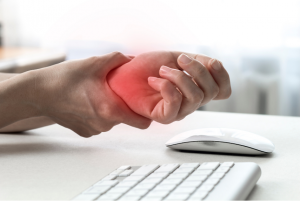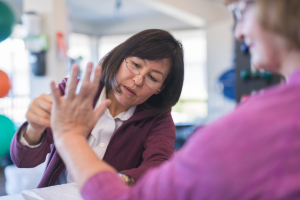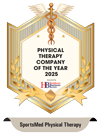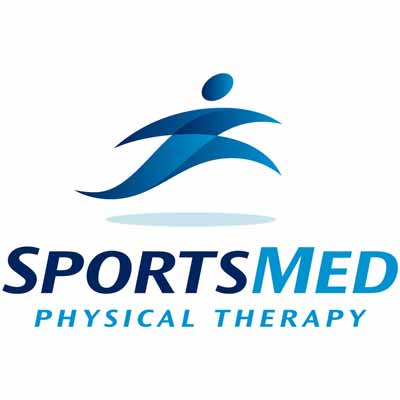By SportsMed Physical Therapy
If you read our previous blog about common orthopedic injuries in female athletes, you already know that certain injuries occur more frequently in women in part due to their structural differences (in bones, ligaments and other tissues) from men, as well as hormonal fluctuations (such as higher estrogen).
These reasons also apply when considering that women tend to experience certain painful conditions of the hands and upper extremities at a higher frequency than men. Additionally, daily activities that women typically engage in can also contribute to or exacerbate these problems.
For example, it’s common for women to engage in activities that require repetitive use of the hands and arms, such as typing, cooking, cleaning, and holding and caring for infants. It’s also challenging to fully refrain from activities that require use of the hands and arms, making it difficult to rest the area sufficiently.

We talked to SportsMed Physical Therapy Jersey City Occupational Therapist and Hand & Upper Extremity Specialist Lisa-Marie Pinkston, MS, OTR/L to learn more about common hand injuries in women.
Trigger Finger
Trigger finger, medically known as “stenosing tenosynovitis,” is characterized by a finger getting stuck in a bent position; typically,the finger either stays locked in the bent position, or suddenly pops straight. Trigger finger can also include symptoms such as stiffness, a popping or clicking sensation with movement, and tenderness in the palm at the base of the finger. It occurs more frequently in the thumb, middle, and ring finger.
Trigger finger is one of the most common causes of hand pain in adults, and occurs more often in middle aged women, typically after menopause. Women are especially susceptible to developing a trigger finger due to a variety of hormonal and factors.
Typical hand therapy treatments for trigger finger include stretching exercises and wearing a splint, both at night to keep the finger in an extended position, and during the day when engaging in activities or motions that aggravate it. (Check out our Instagram video featuring SportsMed Regional Director of Occupational Therapy Marta Profis, OTR/L, CHT treating a patient with trigger finger and creating her custom splints.)
Carpal Tunnel Syndrome
Carpal tunnel syndrome, or “CTS,” is characterized by symptoms such as hand and/or wrist pain; numbness and/or tingling in the thumb, index, middle and half of the ring finger; weakness in the hand and/or arm; and complaints of “dropping things.”
The symptoms of CTS are a result of pressure on the median nerve, which runs through the carpal tunnel, a narrow space between the bones and ligaments on the palm side of the hand.
Overall, three times more women suffer from CTS compared to men. CTS is also one of the most common diagnoses amongst pregnant people; it most often develops in the third trimester of pregnancy, when hormonal changes and fluid retention is at the maximum.
Hand therapy treatments for CTS include nerve gliding exercises, like the ones featured in this Instagram video. These treatments help relieve the discomfort associated with CTS, and is a safe, effective treatment option that can be performed during pregnancy.
De Quervain’s Tenosynovitis
De Quervain’s tenosynovitis is caused by inflammation of the tendons on the thumb side of your wrist. It is characterized by symptoms such as pain when turning your wrist or grasping something; pain or swelling near the base of the thumb, wrist or forearm; or a feeling of tightness when engaging in thumb movemements. The exact cause of de Quervain’s tenosynovitis isn’t known, but it is correlated with repetitive movements of the hand or wrist, especially those that require gripping.
De Quervain’s tenosynovitis affects women eight to 10 times more often than men. The condition is also often referred to as “Mommy Thumb” given its prevalence among pregnant people and women taking care of infants.
Finkelstein’s Maneuver, which is demonstrated in this Instagram video, is a test to confirm the diagnosis of De Quervain’s. Treatment includes manual therapy over the inflamed tendon, rest, and splinting.

Lisa-Marie Pinkston, MS, OTR/L obtained a Master of Science degree in Occupational Therapy from Sacred Heart University. She has 10 years of experience as an occupational therapist and is an Upper Extremity Specialist at SportsMed Physical Therapy Jersey City.
Lisa-Marie enjoys the challenge of treating hands, and the fulfillment she gets from witnessing patients feel better. Lisa-Marie’s favorite part of being an occupational therapist is helping someone on their journey to get back to their life. Whether it be pain, a range of motion limitation, or surgical precautions, the day a patient starts to “feel normal”, she knows she did her job to the best of her ability.






